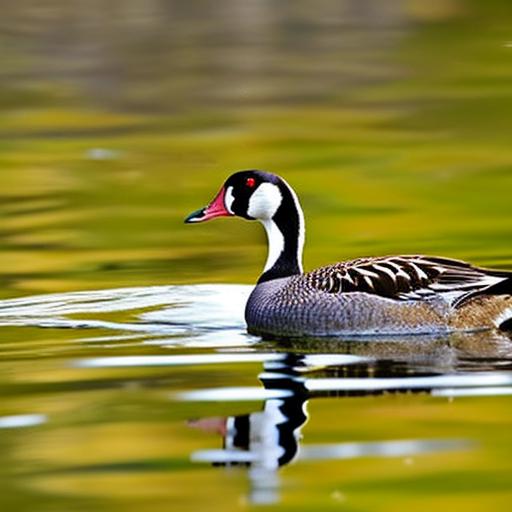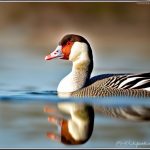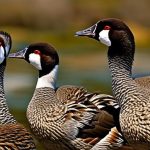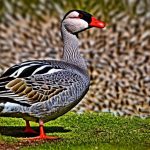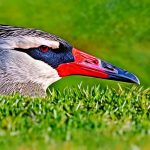Canadian geese are a common sight in many areas of North America, including Canada and the United States. These large waterfowl are known for their distinctive honking calls and V-shaped flight formations. While they can be a beautiful addition to the natural landscape, they can also become a nuisance when they invade certain areas such as parks, golf courses, or residential neighborhoods. Understanding the behavior of Canadian geese and knowing how to effectively deter them from these areas is important for maintaining a clean and safe environment.
Key Takeaways
- Canadian geese are highly adaptable and intelligent birds that can quickly become a nuisance if not properly managed.
- Natural deterrents such as planting certain types of vegetation or using dogs can help discourage geese from settling in an area.
- Physical barriers like fences or netting can be effective in keeping geese away from specific areas.
- Sound and visual repellents like scarecrows or reflective tape can be used to startle geese and discourage them from staying in an area.
- Properly managing water sources by reducing access or adding deterrents like floating alligator decoys can help deter geese from congregating in an area.
Understanding the Behavior of Canadian Geese
To effectively deter Canadian geese, it is important to understand their behavior. Canadian geese are monogamous birds that mate for life. They typically nest near bodies of water, such as ponds or lakes, and prefer areas with tall grasses or shrubs for cover. The female goose will lay an average of 5-6 eggs in a nest made of grass and feathers. Both parents take turns incubating the eggs for about a month until they hatch.
Canadian geese are herbivores and primarily feed on grasses, aquatic plants, and grains. They are often attracted to areas with lush vegetation and open spaces where they can easily spot predators. Understanding their nesting habits and feeding patterns can help in implementing effective deterrent strategies.
Natural Deterrents for Canadian Geese
One way to deter Canadian geese from certain areas is by using natural deterrents. Planting certain types of vegetation that geese find unappealing can discourage them from nesting or feeding in those areas. For example, tall grasses or shrubs with thorns can make it difficult for geese to access their preferred nesting sites.
Another natural deterrent is the use of decoys. Placing realistic-looking decoy geese near water sources or open spaces can trick real geese into thinking the area is already occupied, causing them to seek out other locations. These natural deterrents can be effective in deterring geese, but they may require regular maintenance and monitoring to ensure their effectiveness.
Creating Physical Barriers to Keep Canadian Geese Away
Physical barriers can be an effective way to keep Canadian geese away from certain areas. Fencing or netting can be installed around ponds, lawns, or other areas where geese are not wanted. The fence should be at least three feet high and have small enough gaps to prevent geese from squeezing through. Netting can be used to cover bodies of water to prevent geese from landing and swimming.
It is important to properly install and maintain these barriers to ensure their effectiveness. Regular inspections should be conducted to check for any damage or gaps that geese could exploit. Additionally, any vegetation that grows near the fence or netting should be regularly trimmed to prevent geese from using it as a launching pad.
Implementing Sound and Visual Repellents
Sound and visual repellents can also be effective in deterring Canadian geese. Scarecrows or other visual deterrents can be placed in open areas to make geese feel threatened or uncomfortable. These visual deterrents should be moved regularly to prevent geese from becoming accustomed to them.
Noise-making devices, such as propane cannons or ultrasonic devices, can also be used to deter geese. These devices emit loud noises or high-frequency sounds that are unpleasant for geese and can discourage them from staying in the area. It is important to follow local regulations and guidelines when using these devices, as they may have restrictions on noise levels or usage times.
Properly Managing Water Sources to Deter Canadian Geese
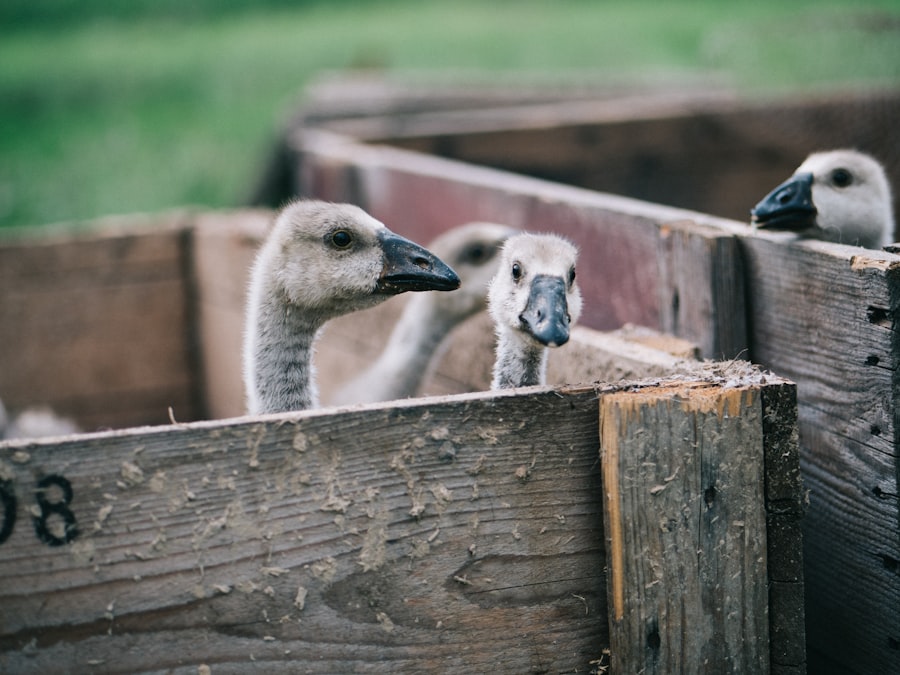
Properly managing water sources such as ponds or lakes is crucial in deterring Canadian geese. Geese are attracted to bodies of water for nesting and feeding purposes. To discourage them from staying in these areas, it is important to maintain a clean environment. Regularly removing any debris or vegetation from the water can make it less appealing for geese.
Additionally, creating a steep shoreline or installing floating islands can make it difficult for geese to access the water. These physical modifications can discourage geese from landing and swimming in the area. It is important to consult with local authorities or experts before making any modifications to natural water sources to ensure compliance with regulations.
Utilizing Scents and Taste Deterrents
Scents and taste deterrents can be effective in deterring Canadian geese. Certain scents, such as grape extract or peppermint oil, are unpleasant for geese and can discourage them from staying in an area. These scents can be sprayed on vegetation or applied to surfaces near water sources or open spaces.
Taste deterrents, such as predator urine or bitter substances, can also be used to discourage geese from feeding in certain areas. These substances can be applied to grass or other vegetation that geese are likely to consume. It is important to follow the instructions provided by the manufacturer when using these deterrents and to regularly reapply them as needed.
Installing Motion-Activated Devices to Scare Canadian Geese
Motion-activated devices can be an effective way to scare Canadian geese away from certain areas. Sprinklers or lights that are triggered by motion can startle geese and make them feel threatened. These devices should be strategically placed in areas where geese are likely to gather, such as lawns or open spaces.
It is important to properly install and maintain these devices to ensure their effectiveness. Regular inspections should be conducted to check for any damage or malfunctions. Additionally, the devices should be adjusted periodically to prevent geese from becoming accustomed to them.
Maintaining a Clean and Tidy Environment to Discourage Geese
Maintaining a clean and tidy environment is crucial in discouraging Canadian geese from nesting or feeding in certain areas. Geese are attracted to areas with abundant food sources and open spaces. Regularly removing any food waste or litter can make an area less appealing for geese.
It is important to properly dispose of waste in designated containers and to regularly clean up any spilled food or debris. Additionally, keeping lawns well-maintained and free of tall grasses or shrubs can discourage geese from nesting in those areas. By maintaining a clean and tidy environment, the likelihood of geese staying in the area is greatly reduced.
Seeking Professional Help for Geese Control
In some cases, it may be necessary to seek professional help for geese control. Licensed professionals have the knowledge and experience to effectively deter geese from certain areas while ensuring compliance with regulations and laws. They can assess the specific situation and recommend the most appropriate deterrent strategies.
When hiring a professional, it is important to choose a reputable company that specializes in geese control. They should have the necessary permits and licenses to carry out the work. Additionally, they should provide a detailed plan of action and offer ongoing maintenance and monitoring services.
Respecting Regulations and Laws when Dealing with Canadian Geese
When dealing with Canadian geese, it is important to respect the regulations and laws surrounding their protection. In many areas, Canadian geese are protected under federal or state laws, and it is illegal to harm or disturb them without proper permits or licenses. It is important to familiarize yourself with the specific regulations in your area before implementing any deterrent strategies.
Respecting these regulations not only ensures compliance with the law but also promotes ethical and responsible behavior towards wildlife. It is important to find humane and non-lethal methods of deterring geese that do not cause harm or distress to the birds.
Understanding how to effectively deter Canadian geese from certain areas is important for maintaining a clean and safe environment. By understanding their behavior and implementing the appropriate deterrent strategies, it is possible to discourage geese from nesting or feeding in unwanted areas. Whether through natural deterrents, physical barriers, sound and visual repellents, proper water source management, scents and taste deterrents, motion-activated devices, maintaining a clean environment, seeking professional help, or respecting regulations and laws, there are various methods available to deter geese. By taking action and implementing these strategies, we can create a harmonious coexistence with Canadian geese while protecting our desired spaces.
If you’re looking for ways to keep Canadian geese away, you might also be interested in learning about how to create a safe and comfortable environment for your chickens. Check out this article on chicken coop interior ideas to discover innovative ways to enhance your coop’s design and functionality. Additionally, if you’re considering breeding chickens, understanding the natural hatching process is crucial. Find out more about how long it takes for chicken eggs to hatch naturally in this informative article: how long for chicken eggs to hatch naturally. Lastly, if you’re wondering whether geese can eat chicken feed, this article provides insights into their dietary needs: can geese eat chicken feed.
FAQs
What are Canadian geese?
Canadian geese are large water birds that are native to North America. They are known for their distinctive black heads and necks, white cheeks, and brown bodies.
Why do Canadian geese need to be kept away?
Canadian geese can cause damage to property, create health hazards, and be a nuisance to people. They can also be aggressive and territorial during nesting season.
What are some methods for keeping Canadian geese away?
Some methods for keeping Canadian geese away include using visual deterrents such as scarecrows or reflective tape, using noise deterrents such as loud noises or predator calls, using physical barriers such as fences or netting, and using taste deterrents such as bitter sprays.
Are there any humane methods for keeping Canadian geese away?
Yes, there are humane methods for keeping Canadian geese away. These include using visual and noise deterrents, as well as habitat modification techniques such as removing food sources or planting vegetation that is unappealing to geese.
Is it legal to harm Canadian geese?
No, it is illegal to harm Canadian geese under the Migratory Bird Treaty Act. This law protects migratory birds, including Canadian geese, from harm, harassment, or killing without a permit.
Meet Walter, the feathered-friend fanatic of Florida! Nestled in the sunshine state, Walter struts through life with his feathered companions, clucking his way to happiness. With a coop that’s fancier than a five-star hotel, he’s the Don Juan of the chicken world. When he’s not teaching his hens to do the cha-cha, you’ll find him in a heated debate with his prized rooster, Sir Clucks-a-Lot. Walter’s poultry passion is no yolk; he’s the sunny-side-up guy you never knew you needed in your flock of friends!

